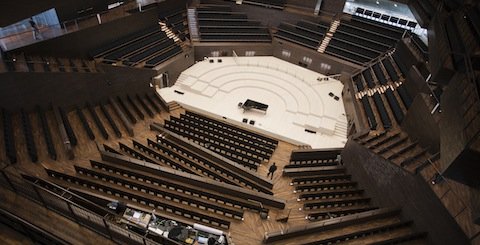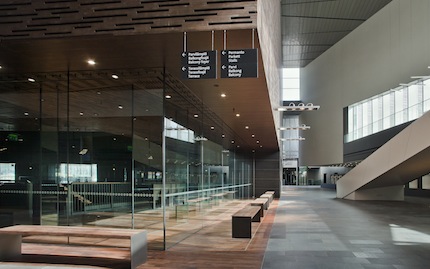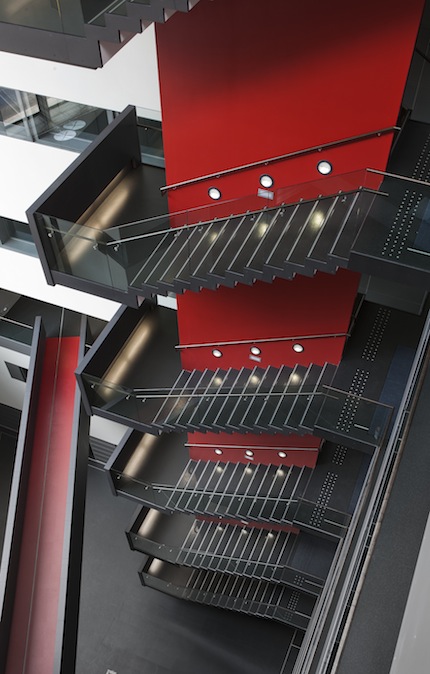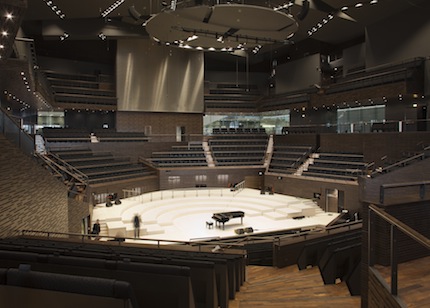
Helsinki’s New House of Music
Orests Silabriedis
03/01/2012
Last spring, Arterritory.com visited Reykjavik’s new Harpa concert hall. Autumn provided a chance to take a walk through Rēzekne’s future concert venue, awaiting its traditional ridgepole celebrations on January 6. In Liepaja, it has been decided that the new concert hall should be ready in 2015. They say that next year will see the completion of the long-awaited Elbe Philharmonic Hall in Hamburg. Not without the insistent pressuring of Mariss Jansons, Munich has finally chosen a site for the construction of a new concert venue. Let’s not even mention Estonia, which has seen concert halls built or renovated in Pärnu, Tartu and Jõhvi in last 10 years or so. Even Paris, without its own hall for so long (just like Riga) is hoping to launch its new philharmonic in the famous Cité de la musique or City of Music in early 2014. These are just a few examples of a similar trend to be observed in many places around the world, and the subsequent text is not about Riga hoping to make do with a rebuilt Congress Centre, but rather about Riga’s nearest large concert hall being open since August in Helsinki. This is the Helsinki Music Centre or Musiikkitalo, at once a permanent home to three entities co-existing in harmony – the Helsinki Philharmonic Orchestra, the Finnish Radio Symphony Orchestra and the Sibelius Academy. The Centre has its own ideological and financial management team, but only in February will its true captain be revealed – the one assuming responsibility for the artistic fulfilment and economic rate of return of Musiikkitalo.

The idea of a new concert hall for Helsinki has been pressing since the 1990s, especially since the Finlandia Hall, drawn by Alvar Aalto and completed in 1971, although impressive, is quite an inappropriate structure for symphonic music concerts in terms of acoustics. Two of the first tasks were hiring an acoustics consultant and holding an international architectural competition. The competition took place 12 years ago and was won by a group of Finnish architects from Turku. The most important condition for the architects was the compulsory co-operation with acoustics specialist Yasuhisa Toyota, one of the world’s most prominent experts in his field; who, by the way, once visited Riga with the aim of eventually participating in the creation of or new concert venue – or that was the plan, at least.
The winners had to comply with building height restrictions and some conformity of the venue’s overall countenance with the parliament building across the street. Also important was the fact that the building was to be located on the same line of landscape (on the shore of the lake) as Finlandia and the Opera. Ultimately, an eight-storey building was created, with two-thirds of it located underground. Its exterior is exceedingly plain, as the main emphasis has been placed on the interior – respectively, the content of the building. Part of this outer image is a patinated copper roof, generally characteristic of Helsinki’s oldest architecture. The large-scale glass facades, on the other hand, fit in well with the more modern buildings of Finland’s capital, including the neighbouring temple of contemporary art, Kiasma. It is interesting that the many underground storeys are also quite filled with light, thanks to the large glassed shaft or atrium, which allows the generous Northern daylight to be manifested to the fullest.

On December 16, I am standing in the Musiikkatalo lobby with music journalist Lauma Mellēna, listening to an energetic young lady talk about the new pride of Helsinki. Among others, mention is made of Thomas Aquinas, who said that a saw made from glass is not beautiful. What is the connection with a glass saw? It turns out to be a poetic allusion to functionality. Not a single detail (!) of the very spacious concert hall does not comply with acoustic requirements. This applies to both the passages through which spectators reach the stalls, as well as the overlay of Finnish birch panel, taking up a precise percentage of the surface and encouraging the immediate rebound of sound. The plan was simple – the acoustic specialist gave the percentages and relationships, and from then on it was the architect’s problem how he dealt with these issues.


The stage is made of Finnish pine, and the boards have no knots. The density of the wood has been precisely calculated, as the stage is the largest and most important instrument resonating in the space. Above the stage, a special concrete object weighing 27 tonnes is hung from 40 steel cables. Four cables of such strength would actually be sufficient to hold the weight, but the builders of the hall wanted to make completely sure, so that the orchestra would not have to steal occasional nervous glances at the threatening object above their heads. The block of concrete serves as the best monitor for the musicians to be able to control the sound. We also learn that the roof of the concert hall has been built from cement, and a thin layer of paper has been placed on top of this cement, ‘working’ in the interest of acoustics. Sound quality does not depend on the amount of people in the hall. “Everything you see in this hall is there in order for the acoustics to be perfect,” our guide Marja-Leena Lehtimäki, Communications Coordinator, tells us, “our goal was to build a world-class concert venue.”
The so-called vineyard style has been used for the hall – Toyota’s favourite audience layout. This means that the orchestra is in the centre of the space, while spectators are placed around it. Marja-Leena explains that the usual classic ‘shoebox’ model is not as effective if the hall is to accommodate more than 1200 listeners. Experts will be better judges of whether this is true (I seem to remember seeing successful shoebox designs even with a higher number of seats), but Helsinki has adopted the vineyard model, and thus in this hall music can be enjoyed by approximately 1700 listeners. Yasuhita Toyota’s philosophy is that the enjoyment of music should be shared – the vineyard design allows viewers to feel a spirit of community in the perception of sonic information. Another of Toyota’s enthusiasms is striving for the presence of the national identity of the respective country. In Helsinki, this is resolved by the interior of the hall being created in resemblance to the polyrythmic arrangement of stones in Finland’s rivers, around which ripple streams full of rapids, or the stairs marked with small lights which weave among the artistically arranged sectors of the stalls. The dark shades of the hall (as well as the lobby), on the other hand, correspond to the murky atmosphere of a Finnish sauna.

All the concerts are completely sold out (although this is not surprising, and apparently happens everywhere during the first season of a new concert hall). On December 17, the Helsinki Philharmonic Orchestra played its final concert of the autumn half-season, led by Estonian master Olari Elts (also well-known in Latvia), Principal Guest Conductor of the Philharmonic. The great event of the concert was the performance of Giacomo Puccini’s opus of his youthful years, Messa di Gloria, also a brilliant display by the State Choir Latvija which has a long history of cooperation with this Finnish orchestra.

Let us look back on this year’s achievements beyond Latvia’s borders. In March 2011 the Latvija choir sung Gustav Mahler’s Symphony No. 8 in Amsterdam’s Concertgebouw under the lead of Mariss Jansons; in October they did the same (also led by Mariss Jansons) in Munich; in June they dazzled the audience of Hamburg’s Laeizshalle under the lead of Simone Young; in July they sung Mahler’s Symphony No.2 in a Greek amphitheatre under a romantic full moon; in September they returned to Hamburg to perform led by Jeffrey Tate, while in Brussels they played together with Andres Mustonen and Vladimir Yurovsky. The performance in Helsinki was thus a pleasant culmination to the year. It must be said that the pleasantness was more symbolic than sonic, however, as the exalted acoustical quality somehow remained hidden. Of course, in comparison with the Finlandia Hall, the orchestra can now build up a splendidly blossoming forte and melt into a fantastic piano on the threshold of audibility, but there was a lack (possibly subjective) of a touch of clarity, which would have brought a magical atmosphere to the event. The sound was good, but slightly lustreless, and quite different depending on the location within the hall. In the first part, I had the opportunity to sit in the best seats, where local and foreign journalists tend to be seated, as I understood. During the second part I listened to the interplay of the choir and orchestra through the music of Puccini while sitting almost level with the orchestra - and it was a completely different orchestra. Not regarding quality (that was consistently excellent), but in the overall cast of the sound. Even stranger was the fact of the choir being squeezed into a quite insufficient space, so that some of the 60 singers had to stand on the floor, not on the platform. Initially, a space for the choir had been planned higher up on the balcony next to the organ, but ultimately the singers have been tucked away behind the orchestra, and it seemed that all the grace and strength characteristic of the Latvija choir, which we also enjoyed this time, did not fully reach the audience.

Finnish critics praised the choir to the skies – the headlines of reviews in both the leading Finnish and Swedish newspapers included hymns to the choir. The praise was deserved, but speaking to the singers made it clear that satisfaction was not high, specifically due to the acoustical qualities of Musiikkitalo. It might seem from the above that it not worth visiting the Helsinki Music Centre. Of course it is worth visiting - as an example of architecture this venue is awfully beautiful and worthy of note. Just take into account that concert tickets should be bought for higher seats, and on this side of the orchestra, not behind it. During the next six months, Musiikkitalo will host a meeting between Olari Elts and Baiba Skride, while the Latvija choir is also likely to be part of one of next season’s concerts. The ferry from Tallinn to Helsinki only takes two hours.